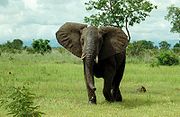Of the five orders, hyraxes are the most basal, followed by embrithopods; the remaining orders (sirenians, desmostylians and elephants) are more closely interrelated. These latter three are grouped as the Tethytheria, because it is believed that their common ancestors lived on the shores of the prehistoric Tethys Sea; however, recent myoglobin studies indicate that even Hyracoidea had an aquatic ancestor.[2] Although morphological evidence continues to support the position of paenungulates with the ungulates, the molecular evidence suggests that Paenungulata is part of the cohort Afrotheria, an ancient assemblage of mainly African mammals of great diversity. The other members of this cohort are the orders Afrosoricida (tenrecs and golden moles), Macroscelidea (elephant shrews) and Tubulidentata (aardvarks).[1]
History
In 1945, George Gaylord Simpson, using traditional taxonomic techniques, succeeded in grouping these spectacularly diverse mammals in the superorder he named Paenungulata ("almost ungulates"). But there were many loose threads in unravelling their genealogy.[3] For example, hyraxes in his Paenungulata had some characteristics suggesting they might be connected to the odd-toed ungulates (Perissodactyla, such as horses and rhinos). Indeed, early taxonomists placed the Hyracoidea closest to the rhinoceroses, because of their dentition, and even some recent evidence suggested a possible affinity of Hyracoidea to Perissodactyla rather than to the rest of the Paenungulata. If true, this would mean that paenungulates are not a clade.
Gallery
A bull bush elephant
|
A manatee and her calf
|
The rodent-like hyrax
|
The desmostylians are the only extinct order of marine mammals
|
The rhino-like embrithopods
|






No comments:
Post a Comment
Note: Only a member of this blog may post a comment.